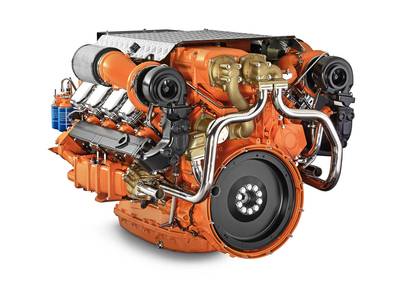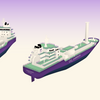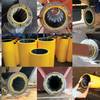Scania 13L Inline; 16L V8 for EPA Tier 3
Scania’s 13-liter EPA Tier 3 engine, intended for propulsion and auxiliary use, along with the 16-liter EPA Tier 3 engine, debuted last month at the Workboat Show in New Orleans. The engines, as are all Scania powerplants, are based on the company’s new modular engine platform, a platform used across marine, industrial, power generation, truck and bus applications globally. The units are built for simplicity of service and repair, and the company is quick to point out that most can be carried out by a single service technician, owing to the fact that each cylinder has its own head, which together with wet cylinder liners makes for easy overhauls in confined spaces. The camshaft is located high in the block and the timing gears are rear-mounted to increase the accuracy of engine timing and reduction of noise. The output ratings for Scania’s newest version of the 13-liter marine propulsion engine ranges from 250-675 hp, and will continue to have outputs up to 750 hp for use in international and exempt markets. For auxiliary applications the range for EPA Tier 3 is 269-426 kW. A few notable points on the engine are Scania’s centrifugal oil cleaner designed to remove small particles from the lubrication oil, while reducing the size of the replaceable filter cartridge. Also, the Scania saver ring placed at the top of each cylinder liner is designed to reduce carbon deposits on the edge of the piston crown and reduces cylinder liner wear. Even with higher performance and tighter emission levels, Scania has been able to increase maintenance and oil change intervals by 25% (now 500 hours) in comparison to its predecessor.
Scania 16-liter V8 EPA Tier 3 Engine
Scania’s 16-liter V8 EPA Tier 3 engine, intended for propulsion and auxiliary use, was also on display in New Orleans. Scania V8 engines are engineered to produce high power while maintaining a size that is compatible for auxiliary equipment. The V design reduces the overall length of the engine which also makes for easy installation. Ancillaries can be effectively accommodated inside the footprint of the engine.
The output ratings for Scania’s newest version of the 16-liter marine propulsion engine ranges from 550-900 hp, and will continue to have outputs between 550-1,000 hp for use in international and exempt markets. For auxiliary applications the range for EPA Tier 3 is 468-553 kW, and the current range will continue to be offered between 430-596 kW for international and exempt markets. Scania said users can also expect to see an increase in the V8’s output ratings that are used for keel cooled applications, moving up to the highest output. Scania also has a new type-approved instrumentation that facilitates installation via a user-friendly and flexible web interface; the marine operator can adapt the information on the displays and choose any required data to be shown. There are program templates for water temperature, engine speed, oil pressure and fuel consumption.
www.scaniausa.com
Scania 13-Liter Inline Engine
Auxiliary power
Power: 269-426 kW at 60 Hz
Propulsion power
Power: 250-675 hp, 186-503 kW
Swept volume: 12.7 liters
Length: 59 in.
Width: 38 in.
Height: 46 in.
Dry weights
With heat exchanger: 2,623 Ib.
With keel cooling: 2,513 Ib.
Scania’s 16-liter V8 engine
Auxiliary power
Power: 468-553 kW at 60 Hz
Propulsion power
Power: 550-900 hp, 405-662 kW
Swept volume: 16.4 liters
Length: 61 in.
Width: 49 in.
Height: 48 in.
Dry weights
With heat exchanger: 3,682 Ib.
With keel cooling: 3,527 Ib.
(As published in the November 2013 edition of Maritime Reporter & Engineering News - www.marinelink.com)











